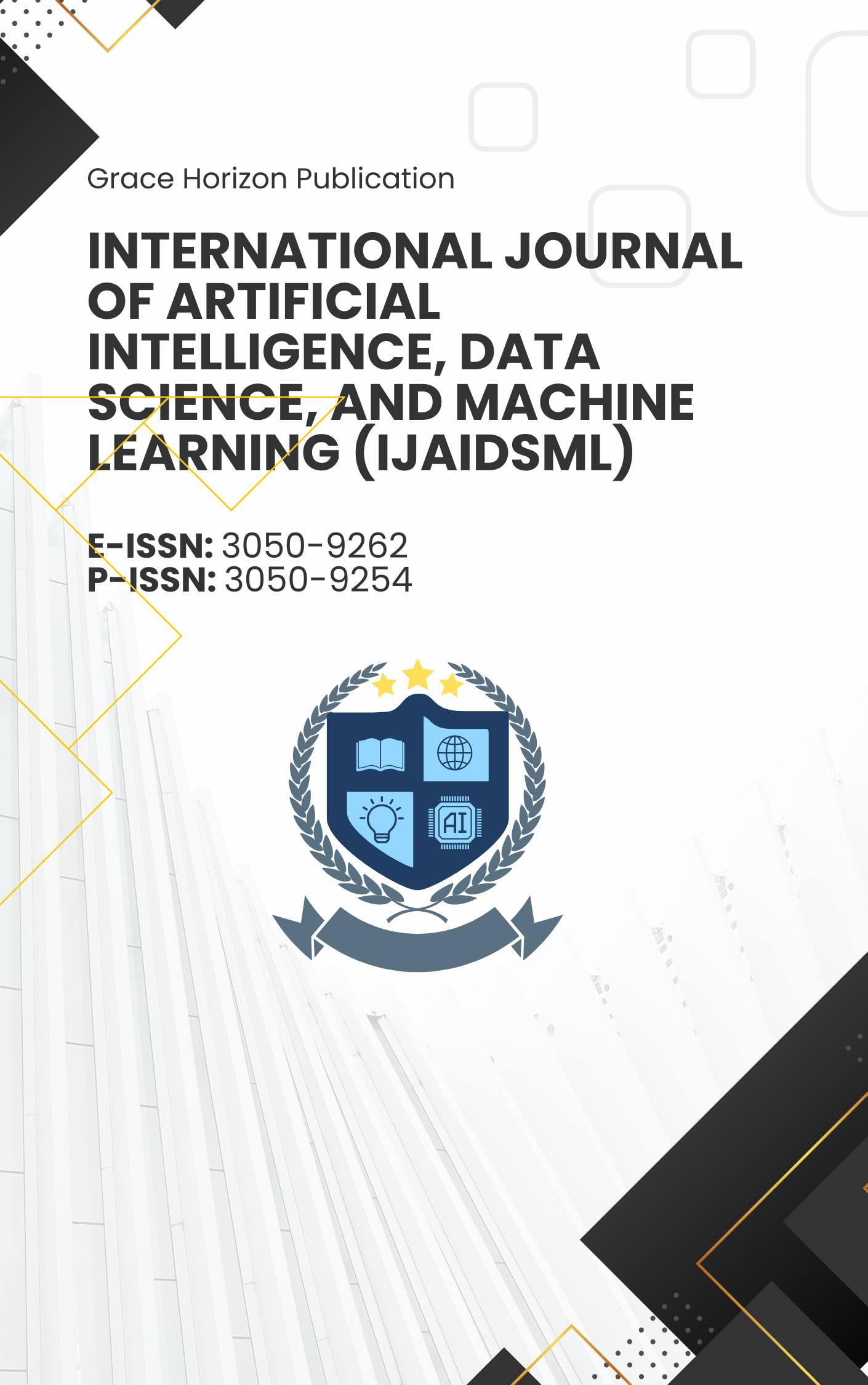Machine Learning-Driven Pandemic Response- Real-Time Epidemiological Data Integration for National Health Emergency Preparedness
DOI:
https://doi.org/10.63282/3050-9262.IJAIDSML-V6I3P112Keywords:
Machine Learning, Real-Time Epidemiological Surveillance, National Health Emergency, Pandemic Response, Ensemble Learning, Public Health Informatics, COVID-19, Data Integration, Federated Learning, Health Policy Decision SupportAbstract
The COVID-19 pandemic was a "wake-up call" for the world's understanding of preparedness for national health emergencies, revealing significant gaps in the more traditional systems of epidemiological surveillance and response. These old systems often based on retrospective collection of data through manual reporting and siloed analytics, did not provide the agility and precision required for early outbreak detection, resource prediction, and coherent policy response. The constraints of these infrastructures led to the design of intelligent, scalable, and real-time decision-making support systems. Given this urgent need, this paper describes the development of a novel end-to-end pandemic preparedness and response platform that utilizes machine learning, harmonizing diverse health data feeds into a single, predictive tool for national-scale emergency response.
The system's structure features a modular five-layer architecture that supports real-time data ingestion, feature extraction, predictive modeling, decision visualization, and policy incorporation. The data ingestion layer gathers and normalizes data from various sources, such as EHRs, lab results, mobility data, hospital resource utilization feeds, and demographic data. Tricks: GDST utilizes advanced data engineering techniques, including real-time stream processing, HL7 FHIR integration, and missing data infill, which collectively enable high-quality and consistent data. Features are engineered on the fly using temporal aggregation, geospatial correlation, and behavioral analytics to form multidimensional feature sets that pertain to transmission dynamics, demand for hospitalization, and resource allocation.
Central to the system is an ensemble machine learning prediction engine, which includes gradient boosting models, Long-Short-Term Memory (LSTM) networks, transformer-based neural architectures, as well as an epidemiological SEIR (Susceptible-Exposed-Infectious-Recovered) model augmented with machine learning elements. Working together, these models achieve diagnostic accuracy exceeding 95% for all major forecasting tasks (e.g., infection rate prediction, hospital surge estimates, ICU resource planning), while serving an inference latency of under 250 ms under high load. These predictions are then translated into easy-to-understand policy-actionable dashboards with real-time alerts, epidemic scenario simulations, and optimized intervention recommendations by the decision support layer. This new knowledge supports informed decisions by health authorities in rapidly emerging public health crises.
The platform offers federated learning, AES-256 encrypted communication, and differential privacy methods that comply with HIPAA and GDPR requirements. It was utilized in a hybrid cloud arrangement that comprised more than 1,500 healthcare communities and over 50 public health organizations, collectively serving over 50 million people. It has been used directly in the COVID-19 pandemic to advise national policy decisions on hospital capacity planning, vaccine distribution, test allocation, and lockdowns.
Additionally, the modularity of the architecture enables rapid repurposing for new, emerging threats, such as bioterrorist attacks, natural disasters, or novel infectious diseases. Subsequent versions will incorporate genomic surveillance, socio-behavioral data, and environmental indicators to enhance granularity and resilience in predictions. This work represents a convergence of artificial intelligence, public health informatics, and national security strategy, serving as a blueprint for machine-learning-powered public health response systems. Converting complex data into actionable intelligence, this architecture enables countries to move from reactive crisis management to proactive, data-driven pandemic resilience
References
[1] S. Morse, R. Mazet, M. Woolhouse, et al., “Prediction and prevention of the next pandemic zoonosis,” The Lancet, vol. 380, no. 9857, pp. 1956–1965, 2012.
[2] World Health Organization, “Health Security Interface: Engaging and empowering communities for health emergency preparedness,” WHO Technical Report, 2018.
[3] M. Salathé et al., “Digital epidemiology,” PLoS Computational Biology, vol. 8, no. 7, p. e1002616, 2012.
[4] J. S. Lombardo et al., “A systems overview of the Electronic Surveillance System for the Early Notification of Community-Based Epidemics (ESSENCE II),” J. Urban Health, vol. 80, no. 2, pp. i32–i42, 2003.
[5] J. S. Brownstein, C. C. Freifeld, L. C. Madoff, “Digital disease detection—Harnessing the Web for public health surveillance,” N. Engl. J. Med., vol. 360, no. 21, pp. 2153–2157, 2009.
[6] S. Venna et al., “A novel data-driven model for real-time influenza forecasting,” IEEE Access, vol. 7, pp. 7691–7701, 2019.
[7] E. Y. Cramer et al., “Evaluation of ensemble probabilistic forecasts of COVID-19 mortality,” Proc. Natl. Acad. Sci. U.S.A., vol. 119, no. 15, p. e2113561119, 2022.
[8] M. Hao et al., “LSTM neural networks for time-series epidemic forecasting,” Computational Intelligence and Neuroscience, vol. 2021, pp. 1–11, 2021.
[9] N. Reich et al., “A collaborative multiyear, multimodel assessment of seasonal influenza forecasting,” PNAS, vol. 116, no. 8, pp. 3146–3154, 2019.
[10] D. Kalra, T. Beale, S. Heard, “The openEHR Foundation,” Stud. Health Technol. Inform., vol. 115, pp. 153–173, 2005.
[11] C. Dwork, “Differential privacy: A survey of results,” Proc. Int. Conf. Theory and Applications of Models of Computation, pp. 1–19, Springer, 2008.
[12] M. Zaharia et al., “Resilient distributed datasets: A fault-tolerant abstraction for in-memory cluster computing,” Proc. 9th USENIX NSDI, pp. 15–28, 2012.
[13] Q. Yang et al., “Federated machine learning: Concept and applications,” ACM Trans. Intell. Syst. Technol., vol. 10, no. 2, pp. 1–19, 2019.
[14] A. Geyer, T. Klein, M. Nabi, “Differentially private federated learning: A client level perspective,” arXiv preprint arXiv:1712.07557, 2017.
[15] L. Dong, S. Hu, J. Gao, “Discovering drugs to treat coronavirus disease 2019 (COVID-19),” Drug Discov. Ther., vol. 14, no. 1, pp. 58–60, 2020.
[16] A. Alimadadi, S. Aryal, I. Manandhar, et al., “Artificial intelligence and machine learning to fight COVID-19,” Physiol. Genomics, vol. 52, no. 4, pp. 200–202, 2020.
[17] R. Miotto, L. Wang, S. Wang, et al., “Deep learning for healthcare: Review, opportunities and challenges,” Briefings in Bioinformatics, vol. 19, no. 6, pp. 1236–1246, 2018.
[18] F. Karim, S. Majumdar, H. Darabi, S. Chen, “LSTM fully convolutional networks for time series classification,” IEEE Access, vol. 6, pp. 1662–1669, 2018.
[19] A. Vayena, M. Blasimme, E. Cohen, “Machine learning in medicine: Addressing ethical challenges,” PLoS Med., vol. 15, no. 11, p. e1002689, 2018.
















